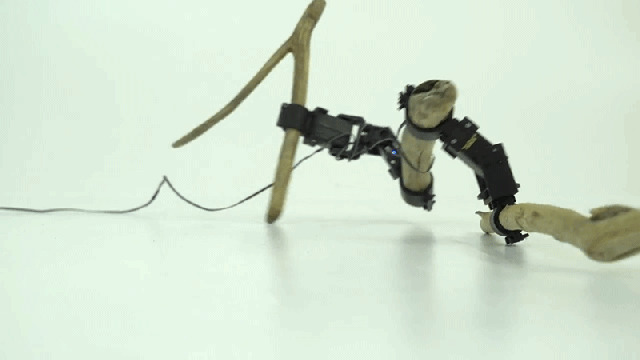Watching Boston Dynamics’ ATLAS robot backflip its way through a parkour course is impressive, but those seemingly effortless maneuvers actually represent thousands of hours of unseen development and testing to perfect. While this robot made from random branches struggling to crawl across the floor is comparatively sad to watch, it represents the future of robotics as the bot learned those moves all by itself.
The robot was created as part of a joint venture between researchers at the University of Tokyo and a company called Preferred Networks, who have expertise in research involving deep learning and artificial intelligence. And that’s the key to how this robot (which is a generous description of this creation) manages to move around no matter what size, shape, or assortment of branches it’s assembled from.
Before it ever takes its first steps, the branches that will be used to build the robot are weighed, scanned in 3D, and then uploaded to a deep learning network. Using this shape and size information, as well as specifics about the type of servos being used to connect the branches and their range of motions, allows an AI to simulate how a prototype robot might move. The simulation rewards movements that are found to produce the longest gaits, and eventually, after trying millions of possible movements, the robot is able to get from point A to point B—just not very gracefully.
Unlike the tricks ATLAS can perform, there is little human intervention required for this robot to learn to walk. The researchers simply had to ensure that any learned behaviours that might easily snap the branches were discouraged, as its scavenged parts are nowhere near as strong as carbon fibre or other exotic materials.
But what’s the benefit when this robot can’t build cars, make traffic stops, or stack boxes in a warehouse? At most, it seems like it’s only useful for generating human pity, but the research has some exciting potential. Robots like ATLAS might one day go into battle for us, so imagine a robot being able to autonomously replace a lost limb with a random object it finds on the battlefield and then learning to move all by itself using the temporary fix so that it can get out of harm’s way and return for proper repairs without putting human soldiers at risk.
The flexibility is the biggest appeal here, using what’s available to accomplish a goal, instead of having to rely on specialised parts or components that might not always be on hand, or available in a timely fashion.
